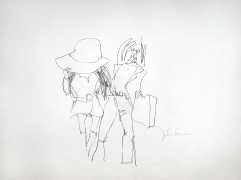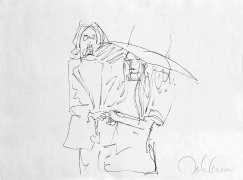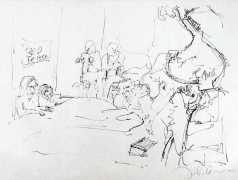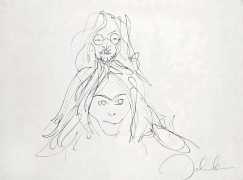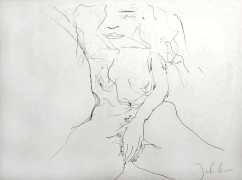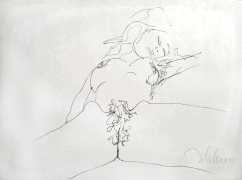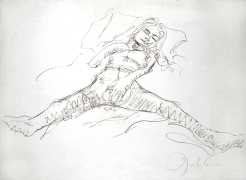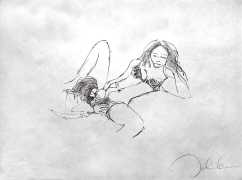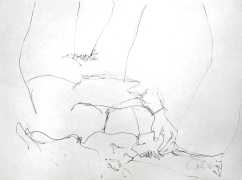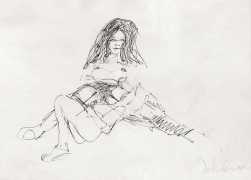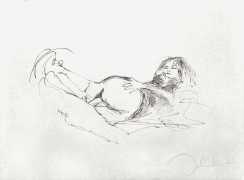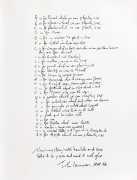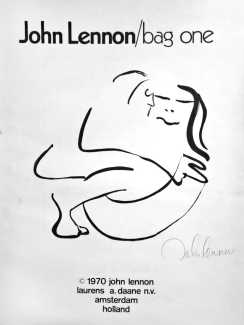 In January 1970 Eugene Schuster’s London Arts Gallery on New Bond Street in salubrious Mayfair was raided by the Obscene Publications Squad, known to many at the time as the ‘Dirty Squad’. The gallery’s new exhibition had only been open for two days, featuring John Lennon’s Bag One – fourteen lithographs, many of them intimate and erotic depicting himself and Yoko Ono in various sexual poses. Each lithograph was for sale for £40 each or £550 for the set, which included a handy leather hold-all to keep them in. The gallery was ‘asked’ to close down immediately, and Schuster was charged under the Obscene Publications Act.
In January 1970 Eugene Schuster’s London Arts Gallery on New Bond Street in salubrious Mayfair was raided by the Obscene Publications Squad, known to many at the time as the ‘Dirty Squad’. The gallery’s new exhibition had only been open for two days, featuring John Lennon’s Bag One – fourteen lithographs, many of them intimate and erotic depicting himself and Yoko Ono in various sexual poses. Each lithograph was for sale for £40 each or £550 for the set, which included a handy leather hold-all to keep them in. The gallery was ‘asked’ to close down immediately, and Schuster was charged under the Obscene Publications Act.
Soon after the forced closure the Director of Public Prosecutions received a letter from a member of the public, a Mr P.F.C. Fuller, warning that if the court case went ahead there was a chance that other art collections throughout the country could potentially be in trouble. In his letter Fuller wrote, ‘I understand that HM the Queen has some highly erotic work by Fragonard’.
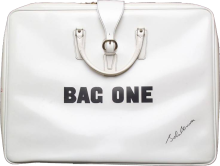 The case went to court in April 1970. The summons, using a law that was 160 years old, alleged that the gallery had exhibited to public view eight indecent prints to the annoyance of passengers, contrary to Section 54(12) of the Metropolitan Police Act 1839. The defence concentrated on the word ‘annoyance’, arguing that it was an integral part of the offence, and Detective-Inspector Patrick Luff of New Scotland Yard told the magistrate that when he went to the gallery on January 15th about forty people were viewing the prints.
The case went to court in April 1970. The summons, using a law that was 160 years old, alleged that the gallery had exhibited to public view eight indecent prints to the annoyance of passengers, contrary to Section 54(12) of the Metropolitan Police Act 1839. The defence concentrated on the word ‘annoyance’, arguing that it was an integral part of the offence, and Detective-Inspector Patrick Luff of New Scotland Yard told the magistrate that when he went to the gallery on January 15th about forty people were viewing the prints.
Mr St John Harmsworth (Magistrate): Were there signs of annoyance?
Detective-Inspector Patrick Luff: I saw no display of annoyance from the younger age group, but one gentleman was clearly annoyed.
Harmsworth: Did he stamp his foot?
Luff: Anger was definitely registered on his face.
Harmsworth: Were there any other responses?
Luff: An accountant from Wandsworth Common told me that ‘he felt a bit sick that a man should draw himself and his wife in such positions.’ It had been a shock, he said, to see a picture of ‘Yoko in the nude with rather exaggerated bosom, with somebody apparently sucking a nipple.’
Amidst much laughter in court the case was dismissed, the magistrate ruling that anyway there are no passengers in a gallery – ‘They have, for the time being, finished passaging.’
It was Anthony Fawcett, Lennon and Ono’s assistant at the time, who first suggested that lithography could be a new creative avenue for Lennon’s art. At first Lennon’s response was ambivalent; the Beatle preferred the spontaneity of drawing cartoons straight onto paper. But Fawcett managed to find a solution. ‘I devised a way to shortcut the complicated procedure of working directly onto stone blocks or zinc plates,’ he later recalled. “By using specially treated litho paper, which I had sent out to his house along with an array of suitable brushes, litho ink, and crayons, John would be able to draw or paint in his usual manner. The images could later be transferred from the paper onto sensitised zinc plates by means of an advanced technical process, and the lithographs printed in the traditional way.’
The impressionistic results were created by Lennon in two phases. The first, drawn around the time of his wedding to Ono in Gibraltar and their subsequent holiday in Paris, were fairly simple depictions of the couple together. The second set, drawn during their Bed-Ins, were far more skilfully crafted, and a lot more intimate, depicting both of them naked in various love-making positions.
Three thousand individual prints were made up, each signed by Lennon, and three hundred complete sets of the fourteen lithographs were packaged in white leather bags emblazoned with the words Bag One in black capitals. The lithographs could be bought for £40 each or a whopping £550 for the set.
Half a century on, the paintings are a lot less likely to cause moral panic. They are, however, also a lot more likely to bankrupt anyone desiring to own one. Currently, the official Art of John Lennon website is selling some of the original signed lithographs for upwards of £10,000.


